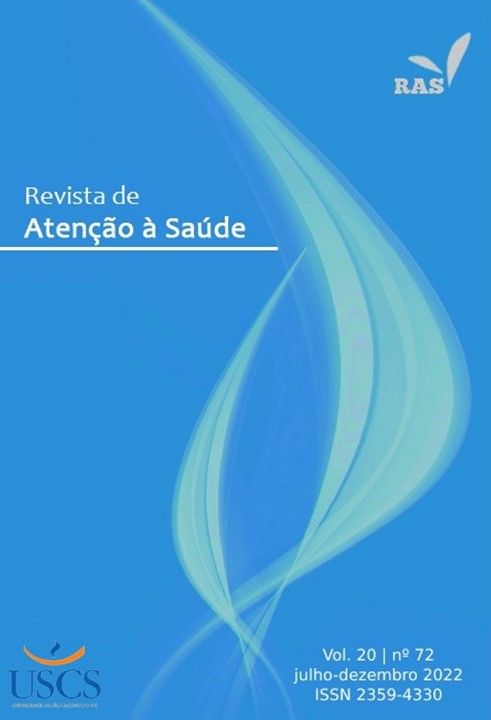USE OF MEDICATION DURING THE COVID-19 PANDEMIC
Medication and pandemics relation
DOI:
https://doi.org/10.13037/2359-4330.8632Keywords:
Increase, Automedication, Use of medicine, Covid-19, Medication, PandemicAbstract
- BACKGROUND: The beginning of the covid-19 pandemic implied social isolation, and made it difficult to access health services, which could lead to an increase in the consumption of medicines, on their own or with a doctor's prescription. The influence of advertisements popularizing drugs with no proven efficacy is also highlighted.
- OBJECTIVE: The present study analyzed whether there was a greater frequency of medication use during social isolation, correlating the fact with variables such as age, sex, drug classes, increased drug dosage and consumption with or without indication.
- METHODS: The study was approved by the Ethics Committee of UNIFAE, CAAE 36933020.7.0000.5382. This is a cross-sectional survey carried out through a questionnaire on Google Forms, using both multiple choice and discursive questions. To verify the data, descriptive statistical analysis tools were used.
- RESULTS: A total of 566 responses to the questionnaire were analyzed, and it was found that 49,82% of the participants use medication for continuous use, of which 19,85% needed to increase the dose. In addition, 57,06% of the participants reported using some other type of medication during the pandemic, 74,6% of which were analgesics, 48,91% vitamins, 48,29% antipyretics, 42,72% anti-inflammatory drugs, 24,76% antidepressants and anxiolytics, 17,95% antibiotics, 16,71% ivermectin, 4,02% nitazoxanide and 1,54% chloroquine.
- CONCLUSIONS: It is concluded that the main classes of drugs used were analgesics, antipyretics and vitamins, with an increase in the frequency of consumption. Such use emerged with the aim of strengthening the immune system, treating feverish symptoms, and treating pain-related complaints, even without a medical prescription.
Downloads
References
Lima DLF, Dias AA, Rabelo RS, Cruz ID da, Costa SC, Nigri FMN, et al. COVID-19 no estado do Ceará, Brasil: comportamentos e crenças na chegada da pandemia. Ciência & Saúde Coletiva [Internet]. 2020 May [cited 2021 Jun 9];25(5):1575–86. Disponível em: https://www.scielo.br/j/csc/a/BtsPz7tPKSDfhTRKMzFCYCR/?lang=pt&format=pdf.
Teich VD, Klajner S, Almeida FAS de, Dantas ACB, Laselva CR, Torritesi MG, et al. Epidemiologic and clinical features of patients with COVID-19 in Brazil. Einstein (São Paulo) [Internet]. 2020 [cited 2021 Apr 22];18. Disponível em: https://www.scielo.br/pdf/eins/v18/pt_2317-6385-eins-18-eAO6022.pdf.
Campos DMO, Oliveira CBS, Andrade JMA, Oliveira JIN. Fighting COVID-19. Brazilian Journal of Biology [Internet]. 2020 Jun 10 [cited 2022 Apr 27];80:698–701. Disponível em: https://www.scielo.br/j/bjb/a/ZYdxZXncVp6PTdwLrHdJfjR/?format=html&stop=next&lang=en.
Arrais PSD, Fernandes MEP, Pizzol T da SD, Ramos LR, Mengue SS, Luiza VL, et al. Prevalence of self-medication in Brazil and associated factors. Revista de Saúde Pública. 2016;50(suppl 2). Disponível em <http://www.scielo.br/scielo.php?script=sci_arttext&pid=S0034-89102016000300311&lng=en&nrm=iso>.
Paumgartten FJR, Oliveira ACAX de. Off label, compassionate and irrational use of medicines in Covid-19 pandemic, health consequences and ethical issues. Ciência & Saúde Coletiva [Internet]. 2020 Sep;25(9):3413–9. Disponível em: https://www.scielo.br/pdf/csc/v25n9/1413-8123-csc-25-09-3413.pdf.
World Health Organization. The Role of the pharmacist in self-care and self-medication: report of the 4th WHO Consultative Group on the Role of the Pharmacist, The Hague, The Netherlands. 1998.
Ministério da Saúde, Secretaria da Ciência, Tecnologia e Insumos Estratégicos, Departamento de Assistência Farmacêutica e Insumos Estratégicos. Prêmio Nacional de Incentivo à Promoção do Uso Racional de Medicamentos. Ministério da Saúde, editor. Comunicação e Educação em Saúde. 2011
Corrêa DAS, Felisbino-Mendes MS, Mendes MS, Malta DC, Velasquez-Melendez G. Fatores associados ao uso contraindicado de contraceptivos no Brasil. Revista de Saúde Pública [Internet]. 2017;51(0).
Cruz PS, Caramona M, Guerreiro MP. Uma reflexão sobre a automedicação e medicamentos não sujeitos a receita médica em Portugal. Rev Port Farmacoter. 2015;7:83–90.
Vitor RS, Lopes CP, Menezes HS, Kerkhoff CE. Padrão de consumo de medicamentos sem prescrição médica na cidade de Porto Alegre, RS. Ciência & Saúde Coletiva. 2008 Apr;13(suppl):737–43.Disponível em: https://www.scielo.br/j/csc/a/VcBmGRRMD7CCDNSPq89Q46J/?lang=pt. Acesso em: 1 jul. 2021.
RANKEL SAO, Sato MDO, Santiago RM. Uso irracional dos anti-inflamatórios não esteroidais no município de Tijucas do Sul. Visão Acadêmica, v. 17, n. 4, 2017. DOI: http://dx.doi.org/10.5380/acd.v17i4.50205.
Wang C, Pan R, Wan X, Tan Y, Xu L, Ho CS, et al. Immediate Psychological Responses and Associated Factors during the Initial Stage of the 2019 Coronavirus Disease (COVID-19) Epidemic among the General Population in China. International Journal of Environmental Research and Public Health [Internet]. 2020 Mar 6;17(5):1729.
Barros MB de A, Lima MG, Malta DC, Szwarcwald CL, Azevedo RCS de, Romero D, et al. Relato de tristeza/depressão, nervosismo/ansiedade e problemas de sono na população adulta brasileira durante a pandemia de COVID-19. Epidemiologia e Serviços de Saúde [Internet]. 2020;29(4).
Oliveira MM de. O uso de antidepressivos por indivíduos sem diagnóstico de transtornos mental na polução geral. [Universidade Católica de Santos, Programa de Pós-Graduação stricto sensu em Saúde Coletiva]; 2018.
Garcias CMM, Pinheiro RT, Garcias G de L, Horta BL, Brum CB. Prevalência e fatores associados ao uso de antidepressivos em adultos de área urbana de Pelotas, Rio Grande do Sul, Brasil, em 2006. Cadernos de Saúde Pública. 2008 Jul;24(7):1565–71. Disponível em:. https://www.scielo.br/j/csp/a/cHKd9QzRBGNPJYBBpSqp7Zv/?lang=pt
Bae M, Kim H. The Role of Vitamin C, Vitamin D, and Selenium in Immune System against COVID-19. Molecules. 2020 Nov 16;25(22):5346.Disponível em: https://www.ncbi.nlm.nih.gov/pmc/articles/PMC7696052/.
Manson JE, Bassuk SS. Vitamin and Mineral Supplements. JAMA. 2018 Mar 6;319(9):859.
Sociedade Brasileira de Infectologia, Associação Médica Brasileira. Informativo conjunto da Associação Médica Brasileira (AMB) e Sociedade Brasileira de Infectologia (SBI) sobre vacinação e tratamento farmacológico preventivo [Internet]. 2021. Disponível em: https://infectologia.org.br/wp-content/uploads/2021/01/informativo-conjunto-da-amb-e-sbi-sobre-vacinacao-e-tratamento-farmacologico-preventivo-covid-19.pdf.
Sociedade Brasileira de Infectologia, Associação Médica Brasileira. Informe da sociedade brasileira de infectologia sobre o novo coronavírus Nº 15: uso de medicamentos para Covid-19 [Internet]. 2020. Available from: https://infectologia.org.br/wp-content/uploads/2020/07/Informe-15-uso-de-medicamentos-para-covid-19.pdf.
Roman YM, Burela PA, Pasupuleti V, Piscoya A, Vidal JE, Hernandez AV. Ivermectin for the treatment of COVID-19: A systematic review and meta-analysis of randomized controlled trials. Clinical Infectious Diseases. 2021 Jun 28
The RECOVERY Collaborative Group. Dexamethasone in Hospitalized Patients with Covid-19 — Preliminary Report. New England Journal of Medicine. 2020 Jul 17;384(8).
Antibiotics - Common Side Effects, Allergies and Reactions [Internet]. Drugs.com. [cited 2022 Aug 16]. Available from: https://www.drugs.com/article/antibiotic-sideeffects-allergies-reactions.html.
Pfizer. Antibiótico: a importância do uso racional. Pfizer. 2019 Jun 17.
Falavigna M, Colpani V, Stein C, Azevedo LCP, Bagattini AM, de Brito GV, et al. Guidelines for the pharmacological treatment of COVID-19. The task-force/consensus guideline of the Brazilian Association of Intensive Care Medicine, the Brazilian Society of Infectious Diseases and the Brazilian Society of Pulmonology and Tisiology. Revista Brasileira de Terapia Intensiva [Internet]. 2020;32(2):166–96.
Fleming-Dutra KE, Hersh AL, Shapiro DJ, Bartoces M, Enns EA, File TM, et al. Prevalence of Inappropriate Antibiotic Prescriptions Among US Ambulatory Care Visits, 2010-2011. JAMA [Internet]. 2016 May 3;315(17):1864.
Kronman MP, Zhou C, Mangione-Smith R. Bacterial Prevalence and Antimicrobial Prescribing Trends for Acute Respiratory Tract Infections. PEDIATRICS. 2014 Sep 15;134(4):e956–65.
Gonzales R, Malone DC, Maselli JH, Sande MA. Excessive antibiotic use for acute respiratory infections in the United States. Clinical Infectious Diseases: An Official Publication of the Infectious Diseases Society of America [Internet]. 2001 Sep 15 [cited 2020 Aug 2];33(6):757–62.
Downloads
Published
Issue
Section
License
Copyright (c) 2023 Mariana Squinca, Ana Flávia Gonçalves Arcuri, Júlia Thaynara Raposo Pereira, Thais de Oliveira Ribeiro, Danyelle Cristine Marini

This work is licensed under a Creative Commons Attribution-NonCommercial-NoDerivatives 4.0 International License.
Policy Proposal for Journals offering Free Delayed Access
Authors who publish in this magazine agree to the following terms:
- Authors maintain the copyright and grant the journal the right to the first publication, with the work simultaneously licensed under a Creative Commons Attribution License after publication, allowing the sharing of the work with recognition of the authorship of the work and initial publication in this journal.
- Authors are authorized to assume additional contracts separately, for non-exclusive distribution of the version of the work published in this magazine (eg, publishing in institutional repository or as a book chapter), with the acknowledgment of the authorship and initial publication in this journal.
- Authors are allowed and encouraged to publish and distribute their work online (eg in institutional repositories or on their personal page) at any point before or during the editorial process, as this can generate productive changes, as well as increase impact and citation of the published work (See The Effect of Open Access).









